Naturalist’s Notebook: July 19 to July 25.
Many sightings of whales would have been overlooked if not for the birds. One of the first things your naturalist tells you is what to look for as signs of whales. Spouts, yes. Body parts, of course. But also, the birdballs. A birdball is, simply, a group of birds moving around very excitedly, very aggitatedly, and very loudly just above the surface. They are not flying high in the air. Nor are they sitting on the surface. They hover just over the surface. A swirling mass of birds low over the surface of the water might indicate that something is pushing fish up from beneath the water. (The birds are hoping to get a mouthful.)
On whalewatching trips, there are seabirds and there are birds you just happen to see while you are on the boat. A true seabird spends nearly its entire life at sea, coming ashore only to build a nest and lay its eggs. And, if it takes the animal three years to reach maturity, then it stays at sea for its first three years.
There are many such birds that spend time around the Cape in the summertime. The largest of these is the Northern Gannet. It can have a wingspan that approaches six feet. As an adult, it is a brilliant shade of white with black wing-tips and a bit of an orangy sheen to its head. It takes them four or five years to mature. The young start out a mottled gray and get more white each year. They are diving birds. Here’s the catch. They dive into the water for their fish from heights above the surface that might be a hundred feet or more. Watching them is really very interesting. They will watch two things while they hunt. They watch the water for signs of fish and they watch each other for signs that their fellows have found fish. Suddenly, the wings get tucked back, giving the impression of going from a cargo plane to a fighter jet, and the gannet drops, head first, into the sea. The bird’s momentum may take it more than twenty feet beneath the surface. Then it is on its way back up, grabbing a fish on its way.
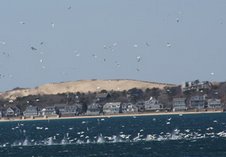
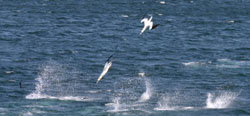
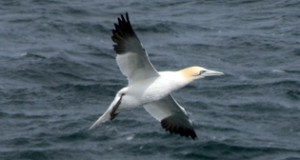
The Manx Shearwater is one of four species commonly found above the nearby waters. These birds, and their cousins (Great Shearwaters, Sooty Shearwaters, and Cory’s Shearwaters) fly low over the water with a mixture of flapping and gliding and feed at the surface or on shallow dives. They eat small fish, squid, crustaceans, and the remnants thrown off of fishing vessels. Manx Shearwaters breed in the northern atlantic, while Great Shearwaters breed in the southern atlantic and Cory’s Shearwaters breed in the eastern altantic and Mediterranean.
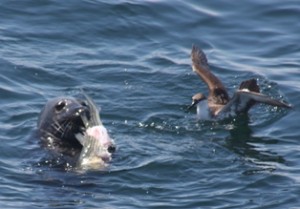
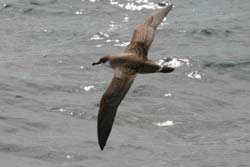
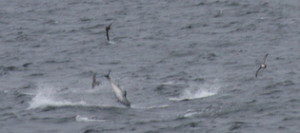
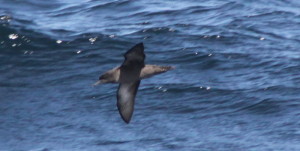
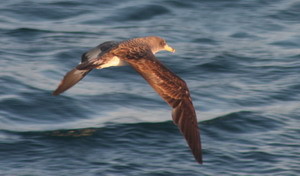
And, if you followed the birdballs this week, they led you to feeding whales. All week long, reports of feeding humpback whales dominated the reports from the naturalists. On July 20, Mark Gilmore reported that a “humpback whale shot right up from under us, feet away, into a chin breach, followed by a kick, net and lunge all within about 10 – 20 feet of us. We were all going crazy!” And Ellie Moody reported on the 21st that “a group of five as feeding right off our bow. We could see right into [their] mouths.”
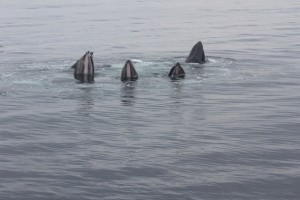
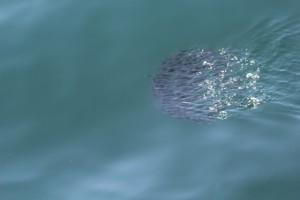
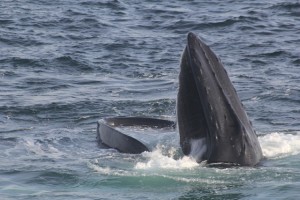
It was not just the humpbacks that were working hard this week. Lunging finback and minke whales were reported on July 19, 20, 21, 22, 23, and 25.
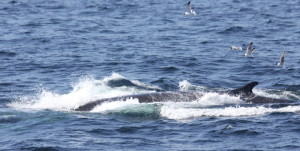
There was other activity too. “Lots of breaching,” was reported by Therese Provenzano on the 19th. Flipper slapping and breaching were reported on both July 20 and July 24. And the 25th was not to be left out.
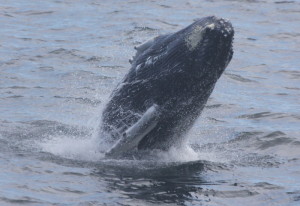
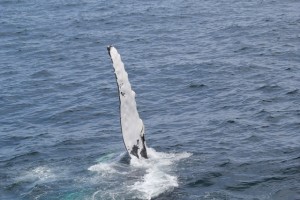
If sheer numbers peeks your interest, Mark Gilmore reports from the 19th what, once the photos are processed, could turn out to be nearly FIFTY humpback whales.
The highlight of the week was probably reported by Ellie Moody. On July 22, she reports that the “afternoon was crazy. Seas calmed and were translucent, allowing looks at feeding boils of striped bass and cruising schools of blues [bluefish]. We had lunging fins and minkes popping up everywhere. Sweet.”
An honorable mention needs to go to the trip on July 25 that reported both a common tern attempting to steal another’s fish and a humpback whale calf playing at being a big whale. The naturalist reports glimpsing the first out of the corner of his eye as it plucked the unlucky fish from the surface water. It took less than a heartbeat for the second to streak in, oddly quiet until it was nearly on top of the first, to suddenly shriek and dart at the poor hard working fishing onebird. The calf mentioned spent quite a bit of time performing the spectrum of humpback behaviors prized by whalewatchers. It rolled around at the surface. It lobtailled and tail-breached. It flipper-slapped. And it acted out full, spinning head breaches in what appeared to this naturalist to be in the super slow motion of a bygone age of Hollywood movies.





